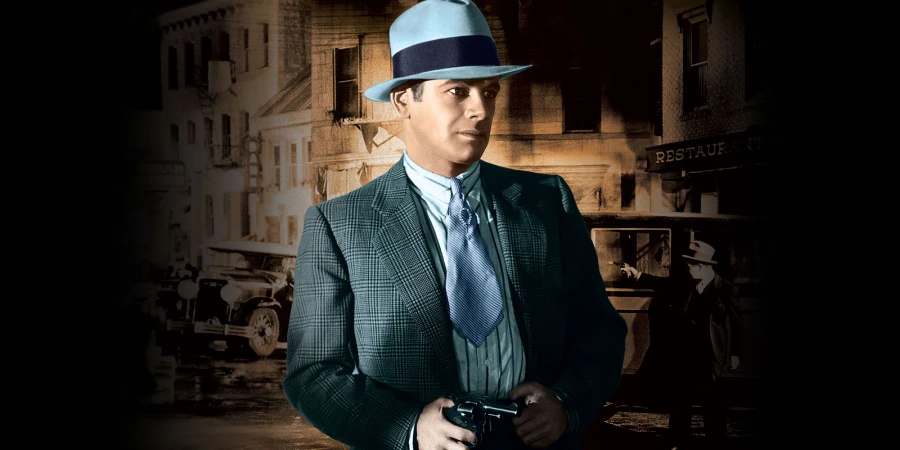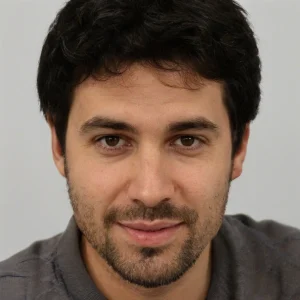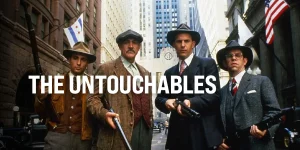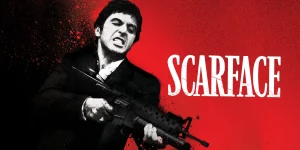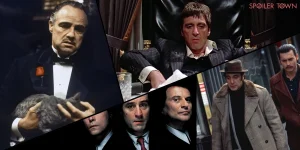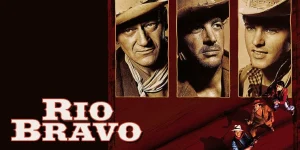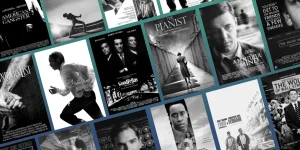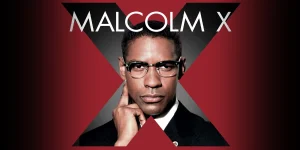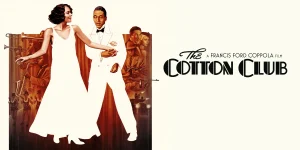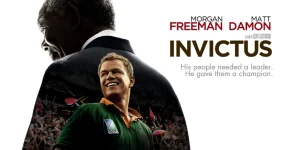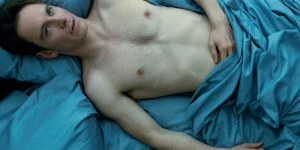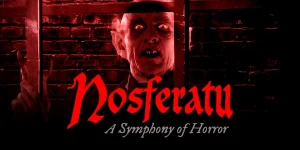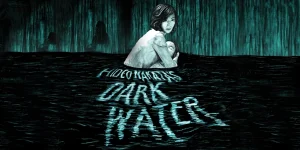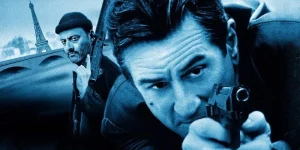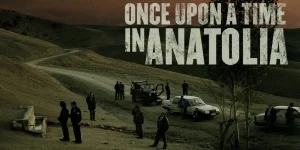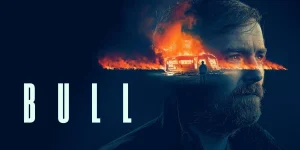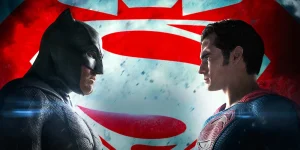Scarface (1932), directed by Howard Hawks and co-directed (uncredited) by Richard Rosson, is one of the earliest and most influential gangster films in Hollywood history. Loosely based on the rise and fall of real-life gangster Al Capone, this film blends brutal realism with stylistic flourishes and social commentary. Its full title is Scarface: The Shame of the Nation, emphasizing its attempt to portray organized crime not as thrilling, but as a societal disease.
Table of Contents
ToggleDetailed Summary
Opening: A City in Chaos
The film opens with a title card explicitly blaming political inaction for the spread of organized crime. We’re then thrust into a dark and violent world where gang warfare runs rampant on the streets of Chicago. The government, police, and media are scrambling to contain the outbreak of bloodshed caused by mob rivalries.
Meet Tony Camonte
Enter Tony Camonte (played by Paul Muni), a brash, ambitious thug with a prominent scar on his left cheek. He works for gangster Johnny Lovo, who tasks him with taking out rival mob leaders and expanding their control of the city. Tony quickly shows himself to be ruthlessly efficient and dangerously impulsive.
His loyalty to Lovo is temporary at best. As Tony gains power and influence, he begins to eye Lovo’s girlfriend Poppy (Karen Morley) and dreams of taking over the entire operation himself.
The Rise of a Gangster
Tony leads a violent campaign to eliminate rival gangs. He uses a machine gun, a relatively new and terrifying weapon at the time, to massacre his enemies. His success comes quickly, and soon he’s sitting at the top of Chicago’s underworld.
However, Tony’s success is shadowed by his obsessive love for his sister Cesca (Ann Dvorak). He is possessively controlling, forbidding her from seeing any men—especially his right-hand man Guino Rinaldo (George Raft), who she is secretly involved with.
Paranoia and Downfall
Tony’s empire begins to crumble when he discovers Cesca with Guino and, in a fit of rage, murders Guino. This act alienates Cesca and signals the beginning of his psychological decline. Meanwhile, the police are closing in on him, and his power begins to slip through his fingers.
His paranoia increases. Former allies betray him, his public image turns sour, and the media dubs him the face of lawlessness in America.
Movie Ending
The final act is pure cinematic tragedy.
Tony is alone and on the run. After a shootout in a safe house, he flees with Cesca, who, despite her anger, still cares for her brother. The police surround their hideout. Cesca, in a moment of complicated loyalty, fights alongside Tony during a tense shootout, only to be fatally wounded in the crossfire.
Devastated by her death, Tony tries to flee but is surrounded. The police offer him a chance to surrender. He refuses. Instead, he attempts to escape and is ultimately gunned down in the street. His final moments are not glamorous—they’re desperate, pathetic, and brutal.
The film ends with a chilling visual: a neon sign flashing the word “The World is Yours”, ironically echoing Tony’s earlier ambitions. The message is clear—his dream led to ruin, not greatness.
Are There Post-Credits Scenes?
No, Scarface (1932) does not have any post-credits scenes. This was not a convention in filmmaking at the time, and the movie ends definitively with Tony’s death and a fade to black.
Type of Movie
Scarface is a crime drama and gangster film. It helped define the genre alongside titles like Little Caesar and The Public Enemy. Its themes revolve around ambition, power, corruption, and the inevitable downfall that follows unbridled greed.
Cast
- Paul Muni as Tony Camonte
- Ann Dvorak as Cesca Camonte
- Karen Morley as Poppy
- Osgood Perkins as Johnny Lovo
- George Raft as Guino Rinaldo
- Boris Karloff (in a minor role)
Film Music and Composer
The film score was composed by Alfred Newman, though music was minimal, as was typical for early sound films. Instead, the movie relies heavily on ambient noise and dialogue to build tension, giving it a gritty and realistic tone.
Filming Locations
The movie was shot almost entirely on sound stages at United Artists Studios in Los Angeles, California. Though set in Chicago, no on-location shooting was done. The urban chaos and tight interiors reflect the claustrophobia and moral decay of Tony’s world, enhancing the film’s noir aesthetic.
Awards and Nominations
Although not a major awards contender upon release, Scarface has since earned its place in film history:
- In 1994, it was added to the United States National Film Registry for being “culturally, historically, or aesthetically significant”.
- Frequently cited in AFI’s 100 Years…100 Movies lists.
- Widely studied in film schools for its direction, editing, and moral ambiguity.
Behind the Scenes Insights
- The film was delayed by censors for over a year due to its violent content and perceived glorification of crime.
- Howard Hawks originally wanted the title to be Scarface: The Shame of the Nation to emphasize the film’s anti-gang message.
- Al Capone reportedly loved the film, despite its loose inspiration from his own life.
- Paul Muni spent weeks studying real gangsters to nail the role’s swagger and speech patterns.
- George Raft’s coin-flipping habit in the film became his real-life trademark.
Inspirations and References
- Inspired by Armitage Trail’s 1930 novel “Scarface”, which was itself a fictionalized take on Al Capone’s life.
- The film draws from real news headlines, public hysteria, and crime statistics of the Prohibition era.
- The “rise and fall” narrative arc influenced later films like The Godfather and Goodfellas.
Alternate Endings and Deleted Scenes
Two different endings were shot due to censorship pressure:
- The original version (more violent and nihilistic) had Tony gunned down without remorse.
- A censored version showed Tony arrested and hanged, placing stronger moral judgment on his actions.
Most modern versions restore the original, more powerful ending.
Book Adaptations and Differences
The movie adapts Armitage Trail’s novel loosely. In the book:
- Tony is more explicitly based on Al Capone.
- The plot has more focus on business dealings and less on personal relationships.
- The incestuous overtones between Tony and Cesca are more subtle in the book than in the film, where it’s disturbingly overt.
Memorable Scenes and Quotes
Key Scenes
- Tony’s first use of a Tommy gun, marking the beginning of his violent rise.
- The restaurant assassination of a rival boss.
- Tony discovering Cesca with Guino, leading to a shocking murder.
- The final police siege on Tony’s hideout.
Iconic Quotes
- “I always tell the truth. Even when I lie.”
- “Do it first, do it yourself, and keep on doing it.”
- “The world is yours!” — flashing on a billboard that haunts Tony’s ambitions.
Easter Eggs and Hidden Details
- The recurring “X” symbol appears during or just before each death scene. This inspired a similar motif in The Departed.
- Tony’s obsession with the neon “World is Yours” sign foreshadows his ambition and eventual downfall.
- Cesca’s dances are subtly choreographed to mirror Tony’s emotional state.
Trivia
- The film was banned in several U.S. states upon release.
- Paul Muni’s makeup scar was based on real knife-fight injuries.
- One of the earliest films to show the machine gun as a signature of mob warfare.
- George Raft was an actual associate of gangsters before becoming an actor.
Why Watch?
If you love classic cinema, crime dramas, or the history of American film, Scarface (1932) is essential viewing. It’s a raw, unflinching look at crime and corruption—way ahead of its time in terms of realism and violence. Despite being nearly a century old, its themes remain relevant, and its influence is undeniable.
Director’s Other Movies
- Bringing Up Baby (1938)
- His Girl Friday (1940)
- Red River (1948)
- The Big Sleep (1946)
- Sergeant York (1941)
Recommended Films for Fans
- Little Caesar (1931)
- The Public Enemy (1931)
- White Heat (1949)
- The Godfather (1972)
- Scarface (1983)
- Angels with Dirty Faces (1938)
- Goodfellas (1990)

